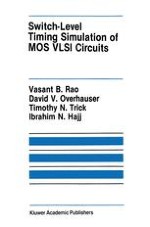1989 | OriginalPaper | Buchkapitel
Simulating Strongly Connected Components
verfasst von : Vasant B. Rao, David V. Overhauser, Timothy N. Trick, Ibrahim N. Hajj
Erschienen in: Switch-Level Timing Simulation of MOS VLSI Circuits
Verlag: Springer US
Enthalten in: Professional Book Archive
Aktivieren Sie unsere intelligente Suche, um passende Fachinhalte oder Patente zu finden.
Wählen Sie Textabschnitte aus um mit Künstlicher Intelligenz passenden Patente zu finden. powered by
Markieren Sie Textabschnitte, um KI-gestützt weitere passende Inhalte zu finden. powered by
In this chapter we discuss the use of a special windowing technique to simulate the blocks within a strongly connected component (SCC). The algorithm presented splits the entire time-interval of interest into various time-slots or windows such that all pairs of signal-transitions take place entirely within one of these windows. This is achieved by maintaining a sequential-list of intervals of transitions which is updated dynamically as the algorithm progresses. The algorithm is, in a sense, event-driven, since only those circuit-blocks that are active within a window are processed and the fanouts of the output nodes of these blocks are scheduled for processing in the future. We begin by reviewing two well-known and classical techniques, namely, the waveform relaxation method and the time-point relaxation method, that could be used to simulate the blocks within an SCC in the network. We will show that neither of these schemes is entirely suitable in our type of simulation; hence, there is a need for the event-driven windowing technique that we will present.
